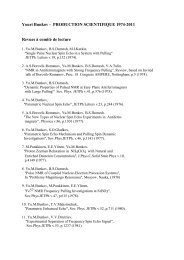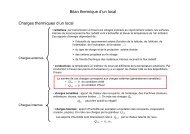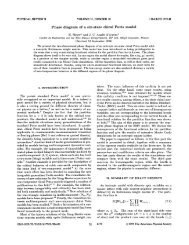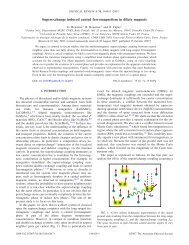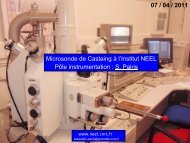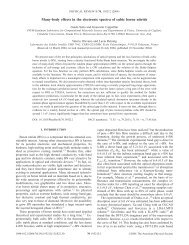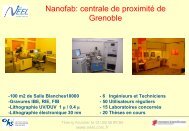Activity Report 2010 - CNRS
Activity Report 2010 - CNRS
Activity Report 2010 - CNRS
You also want an ePaper? Increase the reach of your titles
YUMPU automatically turns print PDFs into web optimized ePapers that Google loves.
TERPYRIDINE-BASED<br />
MACROCYCLES FOR<br />
SWITCHES<br />
HIGHLIGHT : MOLECULAR ELECTRONICS<br />
The POLYSUPRA project , coordinated by<br />
Guy ROYAL (DCM, UJF) with Pierre<br />
TÉRECH (INAC/SPrAM) and Eric<br />
JALAGUIER, Julien BUCKLEY (Léti) as copartners<br />
concerns the preparation and<br />
study of self-assembled coordination<br />
polymers whose originality is to be able<br />
to respond to an external input (stimulus)<br />
that can be optical, electrical or chemical.<br />
The proposed systems are<br />
macromolecules based on polytopic<br />
ligands containing two coordinating units<br />
(terpyridines) bridged by a spacer having<br />
particular redox, optical or chemical<br />
properties. (Fig. 1) These molecules are<br />
particularly attractive for the preparation<br />
of smart materials or for electronic<br />
devices (transistors, memories).<br />
Fig. 1: Schematics detailing the formation of<br />
self-assembled metallo-polymers. The spacer<br />
induces additional chemical properties.<br />
The objectives of POLYSUPRA project<br />
supported by the Foundation are: i) the<br />
preparation and study of new<br />
metallopolymers; ii) the structural<br />
characterization of the polymers; iii) the<br />
attachments of the polymers onto solid<br />
substrates and study of the modified<br />
surfaces and iv) the incorporation of the<br />
systems into electronic devices. At of<br />
spring 2011, the first three tasks have<br />
been successfully realized.<br />
Fig. 2: Electrochromic behavior of a cobalt<br />
polymer.<br />
Structural and Rheological switching<br />
characterization of the polymers and their<br />
attachment onto solid substrates<br />
These metallopolymers can also form<br />
solution or gels, depending on the<br />
experimental conditions and it has been<br />
shown that a reversible gel to liquid<br />
conversion can be electrochemically<br />
controlled by changing the oxidation<br />
state of the metal ions in the polymers<br />
chains (Fig. 3). These polymers have<br />
been characterized using rheology,<br />
viscosimetry and SANS experiments.<br />
Their grafting onto solid substrates is also<br />
under way.<br />
Ox<br />
Red<br />
Fig. 3: Redox controlled Gel/Liquid conversion<br />
CONTACT<br />
guy.royal@ujf-grenoble.fr<br />
FURTHER READING<br />
A. Gasnier et al, Langmuir, 25(15), 8751–<br />
8762 (2009)<br />
A. Gasnier, et al., Inorganic Chemistry, 49,<br />
2592 (<strong>2010</strong>)<br />
Synthesis and study of the<br />
metallopolymers in solution.<br />
Some polynuclear metallopolymers<br />
incorporating a binding unit as spacer<br />
have been prepared and investigated.<br />
These electroactive materials originally<br />
incorporate different types of metal<br />
complexes in the same polymer chain<br />
which induces novel functionalities.<br />
For example, remarkable electrochromic<br />
properties have been demonstrated (see<br />
Fig. 2).<br />
Fig. 4: Cover of the march <strong>2010</strong> issue of<br />
Inorganic Chemistry featuring the first phase<br />
of work supported by this RTRA project.<br />
7



